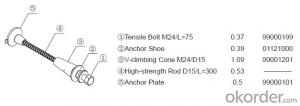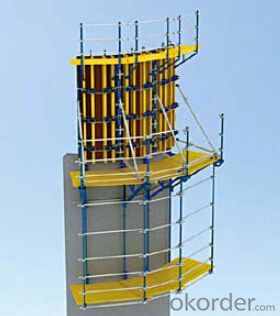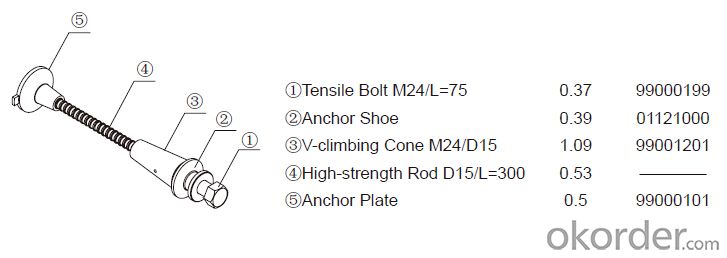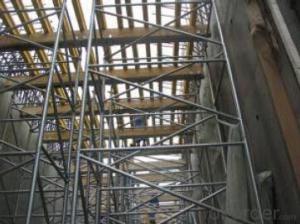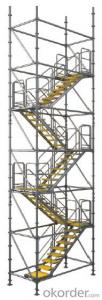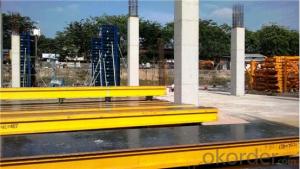Climbing-Platform CP-190 for formwork and scaffolding systems
- Loading Port:
- Tianjin
- Payment Terms:
- TT OR LC
- Min Order Qty:
- 50 m²
- Supply Capability:
- 1000 m²/month
OKorder Service Pledge
OKorder Financial Service
You Might Also Like
Climbing Platform CP190
Climbing bracket CP190 is mainly used as operating platform during construction. It can be used
on the vertical wall and arced wall. The bracket hang on the anchor system and all the load are
supported by anchor system. It’s convenient to assemble and dismantle, the construction is easy,
rapid and safe.
Anchor System:
Anchor system is the most important supporting part. The system is made of five parts shown
below. There into, tensile bolt, anchor shoe and V-climbing cone can be taken out for reusing.
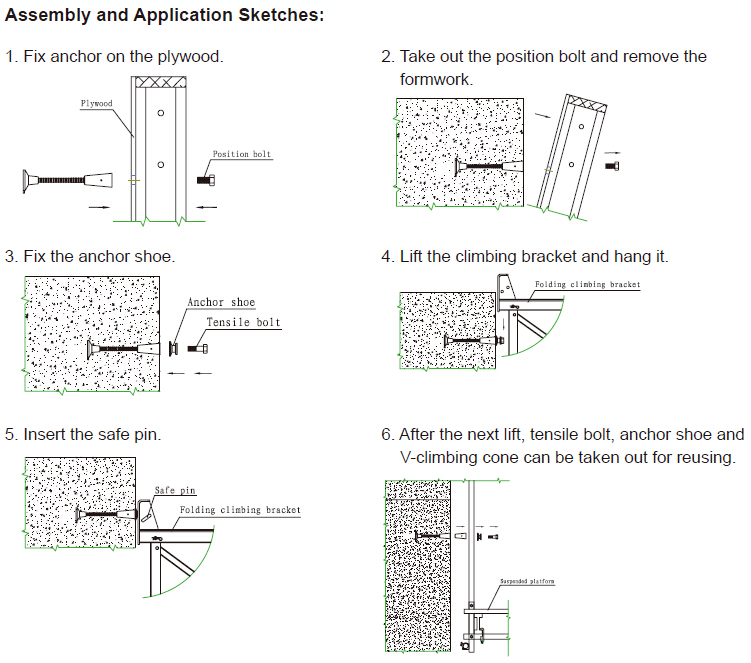
- Q: How does steel formwork accommodate for different concrete compaction methods?
- Steel formwork accommodates for different concrete compaction methods by providing a rigid and stable structure that can withstand the pressure and vibrations generated during compaction. The steel panels and frames used in formwork are designed to be strong and durable, ensuring that they can handle the forces exerted by different compaction techniques such as vibration, tamping, or mechanical compaction. Additionally, steel formwork can be easily adjusted or customized to suit specific compaction requirements, allowing for precise shaping and consolidation of the concrete.
- Q: How does steel formwork handle formwork repositioning?
- Steel formwork is highly durable and flexible, making it ideal for handling formwork repositioning. Its sturdy construction allows for easy dismantling, transportation, and reassembly in new locations. Steel formwork systems typically consist of modular panels that can be easily adjusted and reconfigured to accommodate different shapes and sizes of concrete structures. This versatility and adaptability make steel formwork a preferred choice in construction projects where formwork repositioning is required.
- Q: Are there any regulations or standards that govern the use of steel formwork?
- Steel formwork in construction projects is subject to regulations and standards to guarantee safety, quality, and durability. The American National Standards Institute (ANSI) A10.9-2013 standard is widely recognized for safety requirements in concrete and masonry construction. It provides guidelines for formwork usage, including steel formwork, covering design, construction, inspection, and maintenance. Beside ANSI, the Occupational Safety and Health Administration (OSHA) in the United States and the Health and Safety Executive (HSE) in the United Kingdom establish regulations and guidelines for safe steel formwork utilization. These regulations encompass worker safety, proper assembly and dismantling procedures, and the use of suitable protective equipment. Furthermore, international standards like ISO 9001:2015 for quality management systems are applicable to steel formwork manufacturing and installation processes. These standards guarantee that the steel formwork meets specific quality and performance criteria. Construction companies and contractors must comply with these regulations and standards to ensure worker safety and project success. Noncompliance can lead to penalties, legal issues, and on-site accidents. Consequently, staying up-to-date with the latest regulations and standards related to steel formwork is crucial and their implementation is vital.
- Q: What are the different types of joints used in steel formwork construction?
- There are various types of joints commonly utilized in steel formwork construction, each playing a vital role in ensuring the stability and strength of the system. 1. Butt Joint: This uncomplicated joint involves connecting two members in a straight line, end to end. It is frequently employed in formwork construction to connect steel beams or columns. 2. Lap Joint: In this type of joint, two members overlap and are secured together using bolts or welding. Lap joints are commonly used in steel formwork construction to join horizontal and vertical members, such as formwork panels. 3. T-Joint: As the name implies, a T-joint is created by joining two members at right angles. This joint is commonly used to connect steel bracing members, forming a stable framework for the formwork system. 4. Corner Joint: This joint is utilized to connect two members meeting at a 90-degree angle, ensuring proper alignment and stability of the formwork system. 5. Splice Joint: A splice joint joins two steel members end to end, creating a continuous length. This type of joint is commonly used when longer lengths of steel beams or columns are required in formwork construction. 6. Flange Joint: Flange joints connect two steel members with flanges, such as I-beams or channels. The flanges are bolted together, creating a robust and rigid connection. This joint is often used to connect horizontal beams or columns in formwork construction. Choosing the appropriate joint type is crucial in steel formwork construction, as it depends on specific project requirements such as load-bearing capacity, structural stability, and the type of connections needed for the formwork system.
- Q: How does steel formwork handle concrete curing compounds and sealers?
- Steel formwork is highly resistant to concrete curing compounds and sealers. Due to its non-porous surface, steel formwork prevents the penetration of these chemicals, ensuring that they do not interfere with the curing process or affect the quality of the concrete. Additionally, steel formwork is easy to clean and maintain, allowing for efficient removal of any residual compounds or sealers that may come into contact with it during construction.
- Q: Are there any limitations or disadvantages of using steel formwork?
- There exist certain limitations and drawbacks associated with the utilization of steel formwork. One constraint pertains to the cost. Comparatively, steel formwork tends to be more expensive in comparison to alternative formwork types, such as wood or aluminum. Consequently, it may not be a practical choice for projects operating within tight budgetary constraints. Another limitation involves the weight and unwieldiness of steel formwork. Its substantial weight makes transportation and handling challenging, potentially necessitating additional equipment and labor. Moreover, the bulkiness can complicate the storage and stacking of the formwork when not in use. The assembly and disassembly of steel formwork also require skilled labor. Unlike certain formwork types like modular or reusable plastic formwork, steel formwork often necessitates custom-made fittings at the construction site. This can lead to increased labor costs and elongated construction timelines. Additionally, without proper maintenance, steel formwork is susceptible to corrosion. Exposing it to moisture, chemicals, and harsh weather conditions can result in rusting, thereby weakening the formwork over time. Regular inspections and maintenance are indispensable for ensuring the longevity and safety of steel formwork. Lastly, depending on the nature of the construction project, steel formwork may not be suitable. Its rigidity and lack of flexibility make it less adaptable to complex or irregular shapes. Consequently, alternative formwork materials or systems may prove more suitable in such instances. Despite these limitations and disadvantages, steel formwork also presents several advantages, including durability, reusability, and a high load-bearing capacity. Consequently, it is crucial to thoughtfully consider the project's specific requirements prior to making a decision on whether to employ steel formwork.
- Q: Can steel formwork be used in areas with high chemical exposure?
- Steel formwork can be used in areas with high chemical exposure, but it may not be the most ideal choice. Steel is generally a durable and strong material, but it can be susceptible to corrosion when exposed to certain chemicals. If the chemicals present in the area are known to corrode steel, it is recommended to consider alternative formwork materials such as plastic or aluminum, which may be more resistant to chemical exposure. Additionally, protective coatings or treatments can be applied to steel formwork to enhance its resistance to chemicals. However, it is important to evaluate the specific chemicals and their concentration in the area to determine the most suitable formwork material for the project.
- Q: How does steel formwork compare to timber formwork?
- Steel formwork is generally considered to be superior to timber formwork in terms of durability, strength, and reusability. Steel formwork has a longer lifespan, can withstand higher pressures and loads, and requires less maintenance compared to timber formwork. Additionally, steel formwork provides better dimensional accuracy and consistency, resulting in smoother and more uniform concrete surfaces. While timber formwork may be less expensive and easier to handle, steel formwork offers numerous advantages that make it a preferred choice in many construction projects.
- Q: How does steel formwork handle different concrete surface slip resistance?
- Steel formwork, a versatile and robust material commonly used in construction, is essential for shaping and supporting concrete during the curing process. In terms of managing slip resistance on concrete surfaces, steel formwork offers numerous benefits. Firstly, steel formwork guarantees a smooth and uniform surface for pouring concrete, minimizing variations in slip resistance. Unlike materials like wood, steel does not warp or deform, ensuring consistent contact between the formwork and concrete. This uniformity promotes a more consistent concrete surface, reducing the risk of uneven slip resistance. Furthermore, steel formwork allows for the utilization of different surface treatments and coatings that can enhance slip resistance. For example, before pouring the concrete, anti-slip coatings or aggregates can be applied to the formwork surface, creating a textured surface that improves traction. These treatments can be customized to meet specific requirements for slip resistance, providing design flexibility. Moreover, steel formwork is extremely durable and resistant to wear and tear. This durability ensures that the formwork maintains its structural integrity throughout the concrete pouring process, minimizing the occurrence of surface irregularities that could affect slip resistance. Additionally, steel formwork is easy to clean and maintain, ensuring that any contaminants or debris that could impact slip resistance are promptly addressed. In conclusion, steel formwork effectively manages different levels of slip resistance on concrete surfaces by providing a smooth and consistent surface, allowing for customization through various treatments, and maintaining durability to prevent surface irregularities. Its strength and versatility make steel formwork a dependable choice for construction projects where slip resistance is a concern.
- Q: How does steel formwork handle architectural features such as openings and recesses?
- Steel formwork is a highly versatile and customizable solution that can easily handle architectural features such as openings and recesses. With its strength and flexibility, steel formwork can be shaped and adjusted to accommodate various shapes and dimensions, ensuring a precise fit. This allows for the creation of openings, recesses, or any other architectural feature required in the construction process. Additionally, steel formwork can be easily dismantled and reused, making it a cost-effective and efficient choice for handling complex architectural designs.
Send your message to us
Climbing-Platform CP-190 for formwork and scaffolding systems
- Loading Port:
- Tianjin
- Payment Terms:
- TT OR LC
- Min Order Qty:
- 50 m²
- Supply Capability:
- 1000 m²/month
OKorder Service Pledge
OKorder Financial Service
Similar products
Hot products
Hot Searches
Related keywords

